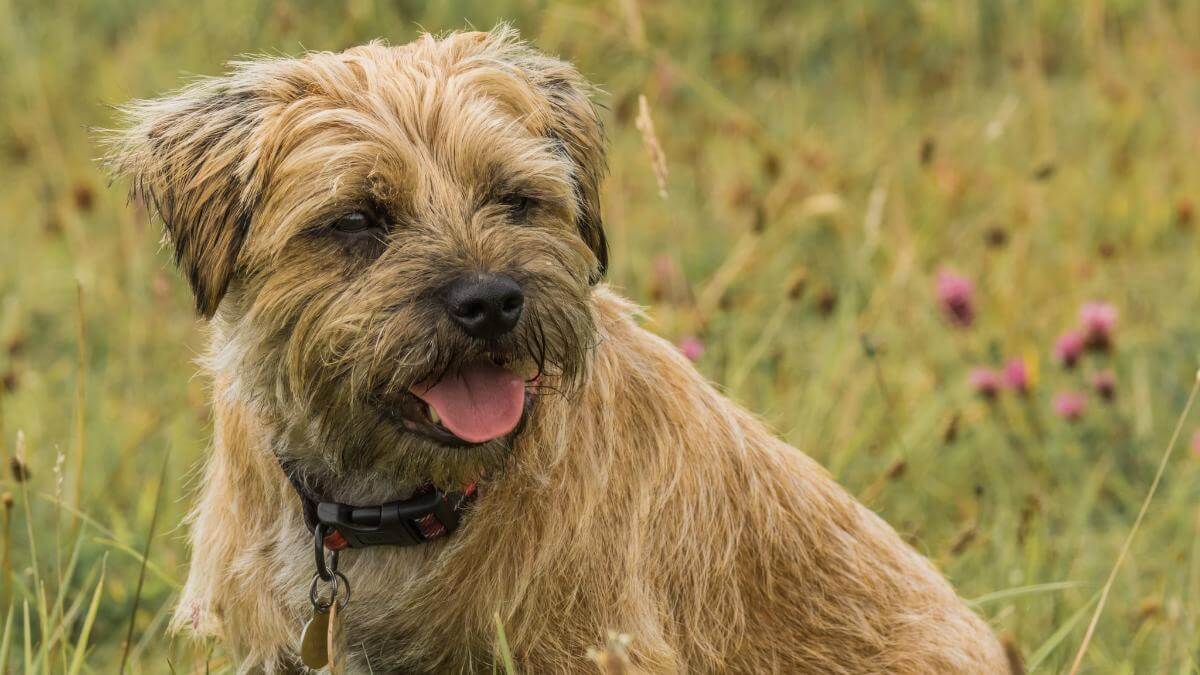


Home » Life With Border Terriers

This article was originally published in Showsight Magazine, April 2013 issue.
The Border Terrier is a hardy, determined little dog that originated in the Cheviot Hills of the Border country between England and Scotland. The farmers and shepherds in this area had to contend with foxes so they depended on small, long-legged terriers to drive them out of the brush and thicket too dense for large hounds. Forced into the open, the game could be pursued by the hounds. Often quarry took refuge underground. But the Border Terriers’ talents in the undergrowth are equally matched by its skills under the earth. Vermin caught in the Border’s sights learned quickly that a den is not a refuge when a Border Terrier is at the door. The development and preservation of the working qualities of the modern-day Border Terrier is credited to two families whose history with hunt terriers dates to the 16th century—the Robsons and the Dodds.
In the US, JoAnn Frier-Murza dedicates much of her life to making certain that owners appreciate the working talents of the Border Terrier. She began hunting with hers in 1971 and attended her first American Working Terrier Association trial in 1972 – she fell in love with the sport. JoAnn pioneered the Earthdog movement in the United States. In 1993 and again in 2003, she worked with the AKC advisory panel to develop and update the earthdog testing program. JoAnn’s Village Green Farm Earthdog Center is the site of many events, and her training, practice and nationwide seminars are very popular. A hunt terrier by definition, the Border had to possess sufficient leg to follow a horse, yet be small enough to pursue a fox underground. Today’s Border Terrier is structurally well suited for these tasks. Moreover, they have a weather-resistant coat that requires stripping to withstand prolonged exposure to drenching rains, mists and other environmental challenges, including the occasional storm drain. There are many stories about Border Terriers that have survived prolonged periods of time underground or in drains when their quarry retreated there.
The Border Terrier’s combination of courage and good sense has always been its best asset. This terrier is lively but wise, brave but not foolhardy, and quick to learn though inclined to think for itself. Its equable temperament, which is unusual amongst terriers, stems from its original work. The Border Terrier was expected to run peacefully with Foxhounds. Therefore, they should not exhibit the dog-aggressive attitude of some terriers that hunt primarily alone. The Robson-Dodds terriers were agile, lean and fast, and their stamina is the hallmark of the breed. Today’s Border is exceedingly versatile. If there is any challenge a Border is not up to meeting, it certainly isn’t for lack of persistence of trying. The Border is a hunter, Earthdog, show dog and obedience and rally dog, outstanding at agility trials and therapy work, a master ratter and has an excellent nose for tracking. There’s not much little this terrier can’t do! There are many qualities of the Border Terrier – courage, boldness and a fun-loving spirit—that may make them somewhat difficult to live with. Hunt terriers were bred to work independently of people, roaming their owners’ property on their own, seeking out and killing rats and assorted vermin.
They were expected to work without human intervention and to make their own decisions. The Border Terrier may, in fact, see their people as nuisances that are interfere with their work! It’s impossible to make any terrier do something it doesn’t want to do. Commands are easily taught to Border Terriers, but, to show independence, they are not always instantly obeyed. Because of their keen hunting instincts, hunt terriers have a remarkable ability to key in on something and tune out everything else around them. That includes their owners’ commands. Training must be fast-paced, fun and designed to take advantage of the Border’s natural intelligence and curiosity. They catch on quickly and become bored with repetition. Keep training sessions short and vary the exercises. Terriers enjoy not knowing what’s coming next, the excitement and mental challenge of problem solving. If you make training too easy, terriers will find something more interesting to do. Border Terriers are highly food-motivated.
Use food treats liberally rather than correcting mistakes. Correction will simply make them more stubborn. Use positive motivation and reward them generously when they’ve done right. For terriers, training must be fun or they will simply refuse to learn. Indeed, the pursuit of fun is the Border’s main goal in life. Anything that prevents them from having a good time becomes an obstacle to overcome. Being very smart and curious, they are able to figure things out quickly and are easily bored by standard obedience classes. With skill and patience, Border Terriers can be trained to meet the high standards for advanced obedience competition. Socialize your Border during puppyhood and adolescence. Some may go through bashful periods. Let him see, hear, investigate and get used to new sights and sounds. Take him places and expose him to the activities he will participate in as an adult dog. Continuing socialization is important at this time and throughout young adulthood so your dog does not become introverted, fearful or defensive towards other dogs. Take care not to allow circumstances to occur which might cause your Border to become defensive or get into a fight.
Though not aggressive by nature, if challenged, they will fight and likely hold grudges against aggressors. As rugged and hard as the Border sounds, its heart is soft. Borders like to stay out of trouble! They are usually good with children – tolerant and patient; but, children must not torment them, hurt them, interfere when they are eating or become frantic. Border Terriers are known to leap up and give a quick, gentle nip on the arm or wrist when they are excited or when children dash by. Teach children to appropriately play and give attention and affection to your dog. Overall, Border Terriers are a healthy, long-lived breed. They need sufficient exercise to keep them fit and happy. Long walks on a leash are best in the country or the city. Excursions can be interspersed with yard time. Be careful that yard time is limited and does not become boring. The Border Terrier has an active, working heritage and likes to have something to do. Anyone who likes terriers should enjoy a Border. They have pleasant personalities, are easy to care for and have an irresistible impish appearance. They are a rare and ‘unspoiled’ breed that makes a splendid companion. They are definitely a dog lover’s dog.